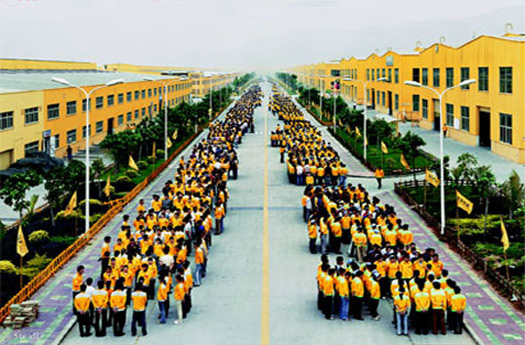
I watched Manufactured Landscapes in the weeks before Christmas and it was just too depressing to post about in the run-up to gift day. Want a new digital camera? Watch as e-waste pollutes the rivers and consumes the lives of Chinese villages? Want something beautiful from abroad? Watch as tankers go to their unquiet rest in Bangladesh, torn apart by men and boys in flip-flops, slipping in the crude.
The documentary, based on the work of photographer Edward Burtynsky, is much more disturbing and depressing than his photographs. Those large-format prints make a sublime beauty out of the most desolate landscapes, the strata of polluted soils showing as flaming highlighted hills, the hills of discarded tires beautified by the tolling of the O shapes in your eyes. Burtynsky says in the film that he tries to make his images devoid of commentary — he is not a documentary photographer, but an art photographer — in order not to turn anyone off. But the film, which loosely covers his taking of the photos in the series, at a string of locations in Asia, with brief inserts of his TED talk, can’t be anything but political. Watching a series of young Chinese women perform repetitive assembly tasks in a vast, gorgeous, color-coded (part and people) factory makes you feel crazy inside. And the cyclical end of those products, also in China, makes you feel sick inside.
Burtynsky’s formalism, and the repetition of specific forms across his many projects, creates some categorical problems. There are a lot of mountains. Many of them might be described as piles of rubble. But all rubble is not alike. Some rubble is circuit boards, some is tires. End-of-use, pollutants, in China they are made and to China they will return. So far so good. But what about the hills of polluted soil, stained by iron ore or coal dust? What about the hills of bricks of towns being taken down for the Three Gorges Dam? I suppose you could argue that these are all bad hills, negative hills, but in one case the hill needs to be saved, in another not produced elsewhere, in another not in place.
And what about Shanghai, where the rubble has been cleared away and replaced by shiny buildings. Is that better? I felt unsettled by the film, but also irritated at it and its subject’s refusal to engage with the cultural context for the images in any depth. It opens with Burtynsky saying that he realized man was making new landscapes on the planet and wanted to document them. OK, fine. But it feels a little too late for this observation to be interesting.
